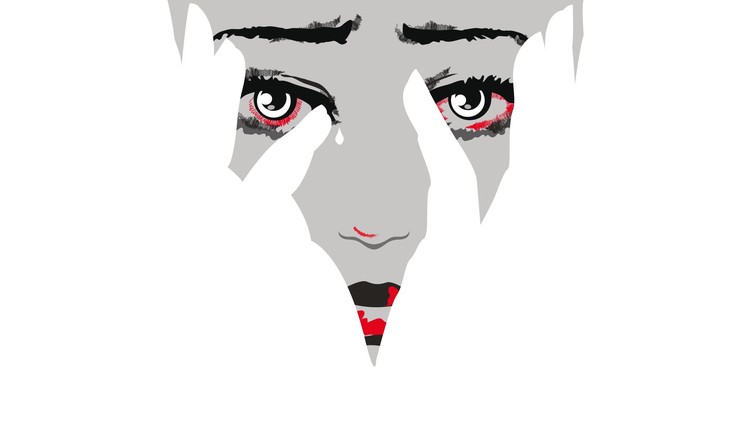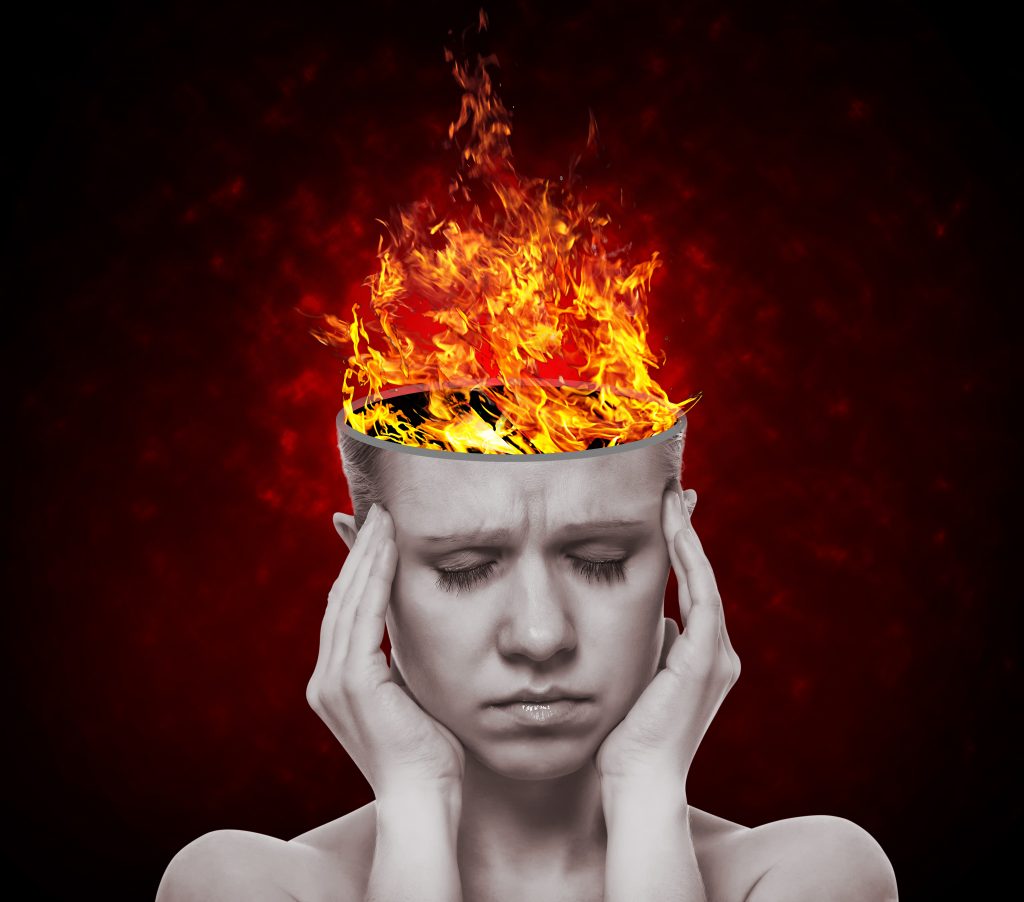If “schizophrenia” and “bipolar disorder” and such are not real “biologically based brain disorders” or “biochemical imbalances” then what does account for the difficult experiences and problems that get people these sorts of labels?
One way of explaining them is as imbalances, though not necessarily “biochemically based” imbalances. (That isn’t to say biochemistry isn’t involved, since as living beings our bodies and brains function through biochemistry.) Instead, the idea is that in responding to life events, some of which may be difficult or overwhelming, our mind can go to extremes of one kind or another, and lose its balance. It can then be difficult, though not impossible, to get back to balance.
Obviously traumatic experience is the most obvious example of this. To get through a traumatic situation, people go to extremes of fight, flight, freeze, and/or submit, in order to survive. The very thing we do to survive may also threaten our wellbeing, so later we might go to an opposite extreme to protect ourselves from the first extreme. Pretty soon, we may feel crazy, and fear that we might be crazy drives us, and often the people around us, to even more extremes. Vicious circles are created.
“Flipping” from one extreme to another is pretty obvious in “bipolar disorder” as people go from very excited to very depressed and lethargic, etc. It isn’t so obvious in “schizophrenia” as the people with these labels often manifest two extremes at once, or they identify as one extreme while fearing persecution by another extreme that manifests as a “voice,” or some other combination. And things get more confused when mental health professionals label extreme versions of normal mental states as pathological, rather than understandable.
I believe the most humanistic way of looking at “mad” mental states is to see them as extreme versions of everyday mental states. When people look at them that way, they can see that they are not so different from other people, and that they do have the option of moderating their extreme states, of finding a middle ground, to come back to the world shared by others.
Of course, it isn’t always as simple as a need to move toward “balance.” Living creatures are not meant to be perfectly balanced; instead, as complexity scientists tell us, life happens “far from equilibrium,” or as a “balance between balance and imbalance.” We are moving systems, and total balance would mean perfect stillness, not a property associated with life! This means that people’s extreme states may also at times have something to contribute, and not just be a problem. So sometimes it is normality that is the problem, and being “more extreme” is actually wise or helpful in a given situation.
I have spent some time mapping out some of the issues people go out of balance around, and identifying what a middle ground might be. I have put many of these issues into a PowerPoint display, which is available here. (Or, if that doesn’t work for you, try here.) I have found it helpful with people to just identify these issues (which are issues we all face) and help people see where they have been going to one extreme or the other, and to help them see they also have the option of trying out the middle ground. Because often when people are “freaked out” they and others around them can’t identify that option.
I think people are healthiest when they see themselves as having options, from the extremes to the middle, and they can pick what best seems to fit a situation. I hope the ideas I am presenting here will help some of you see more options, for yourselves and for those you help. There’s a lot more I could say about all this, so much so that I may write a book around this someday.




I don’t know, if I’m all happy with the terms “im-/balance” here. First, I’d say, an extreme reaction to an extreme experience is perfectly “balanced” – in relation to the experience. If you take the example from your ppt (which I’m only about halfway through though, I have to admit): someone reacts extremely to green coats because s/he was abused by a person wearing a green coat. That may seem imbalanced when the reaction happens towards someone else than the abuser him-/herself, who accidentally wears a green coat. On the other hand, it would seem perfectly balanced to me, as soon as I got to know the history behind, and knew what “green coat” represents.
Another thing is, that I’d differentiate between “balance” and “stability”, with “balance” still being open to change, development and growth, and “stability” (like in “stabilizing” people on drugs… ) meaning a more fixed state, that actually prevents change, development and growth.
Balance is characteristic of nature, or life, and it doesn’t exclude extremes. Stability, an unnatural deadness that excludes extremes, is what our culture, normality, aims at – out of the delusion, that stability would equal balance.
Hi Marian,
I think some of these terms can be tricky, since people mean different things by them at different times.
One way I talk about balance in my seminars is to ask people to stand, or imagine themselves standing, in a perfectly balanced way. Then, I ask them to try to walk forward, without letting themselves move off balance at all. It becomes obvious to them that they way they would begin to move themselves forward is to throw themselves off balance a bit, though that throwing themselves off balance is not great enough to make them fall on their face, just enough to begin to move forward in a new kind of balance, in walking. (Some have called the balance between balance and imbalance, seen in moving systems, a “meta-balance.”)
It’s interesting that while the mental health system often wants to “stabilize” people, it often complains when they have a stability the mental health system doesn’t like – such as very stably holding onto a belief which they system sees as a delusion. Then the system tries to destabilize the belief…..
I think you are correct when you point out it would be quite understandable that someone who was abused by someone wearing a green coat might now have an extreme reaction to someone else wearing a green coat. But that doesn’t mean that such reaction would be without problems: especially if the person didn’t understand why they were reacting that way, or if the reaction was making it hard to get on with the person’s life, they might really interpret it as a “crazy” reaction, and try to get rid of it. (For example, what if the person can no longer hold a job, because of getting freaked out by people in green coats?) One way of protecting oneself from reacting too strongly to green coats would be to go to the opposite extreme, as in the diagram, and dissociating, or disconnecting the past traumatic experience from the current experience of the green coat. But such self protection can itself go to an extreme, but shutting out the perception of possible meaningful connections between past trauma and possible current threat. This kind of process helps explain how people who have been traumatized fail to protect themselves from future trauma (they are trying to protect themselves against making too many generalizations from the trauma, so they end up making too few, they don’t see how they are exposing themselves to the same threat as before.) What people need to do to recover is to find the middle ground, and this is easier to do if they can identify the extremes and what might be the problem with each extreme. (In this case, it might mean sorting out what factors might actually imply danger of more abuse, versus what were just more irrelevant associations.)
I don’t think it is up to the mental health worker to decide what a person’s balance should be – instead it’s helpful to notice that one can go too far in either direction, and then collaborate in sorting out what might fit current situations.
I love your work- and thanks for the useful powerpoint. I do have one question: is the PPT supposed to start on slide #6 or is this a glitch of some kind?
Keep on speaking the truth- someday the mental health system will have to listen.
I’m glad you liked the PowerPoint! As far as it starting at “slide 6” I’m not sure why it says that, but it does that in my version too, nothing is missing.
“biochemical imbalances” is told so the psychiatrist can pretend to be just like a real doctor, treating a physical disease. If the patients did not have a brain chemical imbalance, how could they justify applying chemicals to the patient?
Fear or joy is not a disease unless or until the fear/joy stops the logical rational mind, the ability to communicate.
In children, their fear and joy can go to extreams, because they are children. It is expected in children, and their parents are supposed to guide them .
When adult we are expected to temper our emotions from our internalized parent.
Why would/does the emotions of fear/joy overwhelm the (adult) person?
I don’t know? They lose their internal parent?
What happens when your average teen goes away to College/University? Many overindulge.
The fear of the unknown consequences of a patients “joy” makes their family/friends put the person-patient in hospital to control the possible “joy” actions.
The concern for a patient in “fear” ( doesn’t eat or go outside) from their family/friends makes them put the person-patient in hospital to force food etc.
Forced help usually goes badly.
The problem with psychiatry and the medical model, is that it presumes the person-patient can not learn to cope with their emotions( a broken brain), and secondly doesn’t confront the patient with what the problems (the patient is performing) are.
People can change given information, tools and motivation.
Using meds-chemicals-drugs to control the mind and emotions will never work in the long run.
Ron: I see what you mean, but I don’t know whether finding a middle ground is a question of quantity, or rather of quality…
Personally, I found that my “paranoia” in a way altogether was quite reasonable, although I had to do some re-interpretation of it: of course, the average customer at the supermarket can’t literally read my thoughts, see right through me, and isn’t out to get me. And neither is my mother anymore, while her “having been out to get me” – combined with her flat refusal to admit it – undoubtedly was the initial reason for me to create an alternative persecutor. Nevertheless, the re-interpretation of my “paranoia” did open my eyes to a whole lot of things going on in this world, that render “unreasonable paranoia” a completely reasonable sense of reality.
Interestingly, the in my comment on your “Officially censored!”-entry mentioned owner of the Danish website also called me “paranoid” after he’d visited my blog, because of my thoughts about the system, its purpose, and the way it works.
Now, I can’t expect anyone to believe, that the average customer at the supermarket is out to get me. What I think, I can ask people to believe, or at least try to understand, is a) that my thoroughly narcissistic mother indeed was “out to get me”, and b) that our egocentric culture is “out to get” everybody, and make everybody an object of its insatiable greed for ever more power and profit.
So, basically, what brought me back to the middle ground, wasn’t a dismissal of a certain amount of “paranoia” as “unreasonable”, but rather the insight, that its expression wasn’t to be taken literally but symbolically.
Applied to the green coat: the website-owner was told, that his fear of green coats was completely unreasonable, a meaningless symptom of brain disease, and that he would have to forget all about it. He ended up at the opposite extreme, dismissing all caution in regard to green coats as “paranoia”, a product of his diseased brain. While the whole lot of my fear of green coats was acknowledged as legitimate and reasonable enough, although it also was suggested to me to re-interpret. And although my therapist didn’t intend nor encourage my re-interpretation to go far beyond my mother’s narcissism, she couldn’t but acknowledge, that my further application to the mh system, and to society, our culture, civilization, in general, made perfectly sense.
And even if it’s not a pleasant insight to face, I can live and function with it. Which was a lot more difficult as long as it came along in the shape of a green coat.
Thanks, Mark and Marian, for your comments. I think your story Marian fits in well with my sense of how extremes happen. At one point you were probably too trusting of your mom, based on general assumptions you made about the normal people in your life being trustworthy. Then it became more important for you to see this wasn’t always true, but to do so it first seemed necessary to question all your assumptions about who is safe or not, so you suspected, as you put it, everyone in the store. Later you were able to tone down your suspicion, you were able to see that all of them were not literally true, even though your old ideas about everyone being completely safe and trustworthy were not true either.
Young people naturally experiment with extremes before they find their own balance, as Mark pointed out. They can get in trouble with this, but they can also sort things out, as Marian did, if they are lucky or if they are given support in doing so.
I forgot to mention something above: my mother can’t be out to get me anymore, and hasn’t been able to since 1991, the year she died. That didn’t stop her (voice, and at times even a very real sensation of her physical presence) from “haunting” me.
It’s funny. She always said, she was the only person in the whole wide world I really could (and would have to!) trust, and that I myself was the last person I could trust. And then it turned out, she was the last person I should have trusted…
And yeah, of course I trusted her, especially to start with. I had to. On the other hand, I can’t remember ever to have felt safe, trusting her. – How could I trust someone, who didn’t know how to trust herself? To use a label: “narcissist”, yep. -So, it actually was like both extremes at the same time. The tough part then, was to learn to trust myself, and others who my intuition and perception told me were safe and trustworthy. One huge step on that way was having my feelings of insecurity towards my mother validated. That made it possible for me to see others as who they were, not as potential re-incarnations of my mother.
And, btw, I just saw it today again, on this Jani-girl’s father’s blog (the “To my heroes…”-post, no link, it’s simply toxic… ), what the mh system does: “With schizophrenics, you always have to try to rationalize with them. You have to try and point out where their thinking is irrational. It doesn’t work right then and there but the hope is that it will sink in over time and that Jani will learn to question her own thoughts.” OMG!